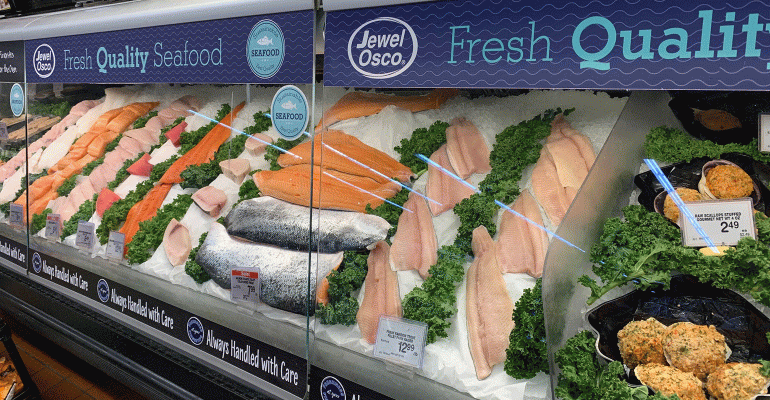Higher seafood prices are having a significant impact on supermarket activity. The reluctance of consumers to pay what they perceive as excessive amounts for many species of finfish and shellfish not only is limiting seafood department revenues but impacting total store sales as seafood customers typically have significantly higher overall basket sizes than non-buyers.
While prices of some species are declining as harvests improve, overall seafood prices still rose 9.8% over the last year, reported Information Resources Inc. (IRI), a Chicago-based market research firm. Fresh seafood dollar sales totaled $6.57 billion for the 52 weeks ending Nov. 6, 2022, down 7.8% versus the year earlier period. Volume sales, meanwhile, fell 16.1%.
Salmon, the most popular fresh finfish with a 67.8% category share, had a 12.4% price increase from a year earlier with a subsequent 3.9 % volume decline, but an 8% increase in dollar sales. Crab, shrimp and lobster, the top-3 shellfish, had volume drops of 23.7%, 21.3% and 7.8%, respectively, along with dollar sales declines of 23.4%, 13.3% and 18.2%.
Yet, the longer-term outlook for sector activity is bright as prices of more species are likely to fall over the next year as inventories increase, said Chris DuBois, IRI senior vice president of the protein practice. He said that crab prices already were down 14% in the four-week period ending Nov. 6 versus a year earlier, with volume sales increasing 18.4%. “Lower prices are going to bring customers back and result in more excitement in the seafood case,” he said. “The seafood department is setting up for a particularly good 2023. It is a big deal because some retailers had given up hope on some of the species.”
Indeed, DuBois said the prospect of merchandising additional species next year “is one of the biggest opportunities for retailers.” Many supermarkets are reluctant to stock expensive fresh options because of concerns about generating shrink from unsold items. Some retailers, meanwhile, have been adding less visually appealing frozen selections to increase varieties without generating waste, he said. “Instead of displaying tuna on ice in the refrigerated case at twenty dollars a pound, operators are selling six- or eight-ounce frozen tuna steaks in attractive packaging for fourteen or fifteen dollars a pound,” DuBois said.

Spotlighting product attributes on signage can make seafood more attractive in a high-priced environment.
Though price is the key component for driving seafood sales, retailers can further increase activity by spotlighting other product elements, such as area of origin and the sustainability methods followed by product suppliers, DuBois said. Displaying certification logos on signage from sustainable seafood organizations and listing sourcing data can impact customer decision-making, he said. “It is important to tell shoppers the whole story of how the seafood goes from boat to shore,” DuBois said, noting that retailers can effectively provide such data via in-store signage and videos and online messaging.
Offering a myriad of price-attractive species also is crucial for generating greater store revenues, DuBois said. “Seafood shoppers are much more likely to also buy the 750-milliliter wines, the higher priced produce, specialty cheeses and craft beer,” he said. Indeed, the Power of Seafood 2022 report, published by the Arlington, Va.-based food industry association FMI, said that the average shopper basket size of $42 increases to $95 where there is fresh seafood in the cart, and to $110 with frozen seafood.
It is especially critical for salmon to have attractive pricing, regardless of the retailer’s profit margin, because of its power in luring shoppers to stores, DuBois said, “Salmon is becoming as important to the retailer as ground beef or chicken breast because it attracts the valuable customers,” he said. “Salmon prices have not risen as much as many other species because retailers want to stay competitive with it.”
As category prices decline, however, more seafood operators will be able to maintain a wider mix of traditional and newer selections in the fresh section, DuBois said “Stores have been taking tuna, swordfish and other species out of the case because of the higher costs,” he said. “But as the prices begin to moderate, retailers will have to decide on the species to add back. That is important, because the more excitement you can create in the case, the more people will want to go over and look at it.”
Creating a strategy for educating shoppers on the different options also is vital for spurring sales, DuBois said. “Many millennials in particular still need to learn how to cook seafood and to have the comfort to buy it,” he said. “It is an expensive purchase, but it is the education piece that retailers can win on and that is where you create the loyalty. Pulling in the younger generation is a huge opportunity.”





